If you could have any superpower, what would it be?
Flight? Invisibility? Converting pizza into negative calories?
While all of these have their advantages, in an economy where our attention is the most valuable asset we have, the answer is simple: to become indistractable.
“The superpower I think is the most important of the 21st century is the power to be indistractable. How we control our attention is how we control our life. If you don’t control it, someone will control it for you.”
Nir Eyal
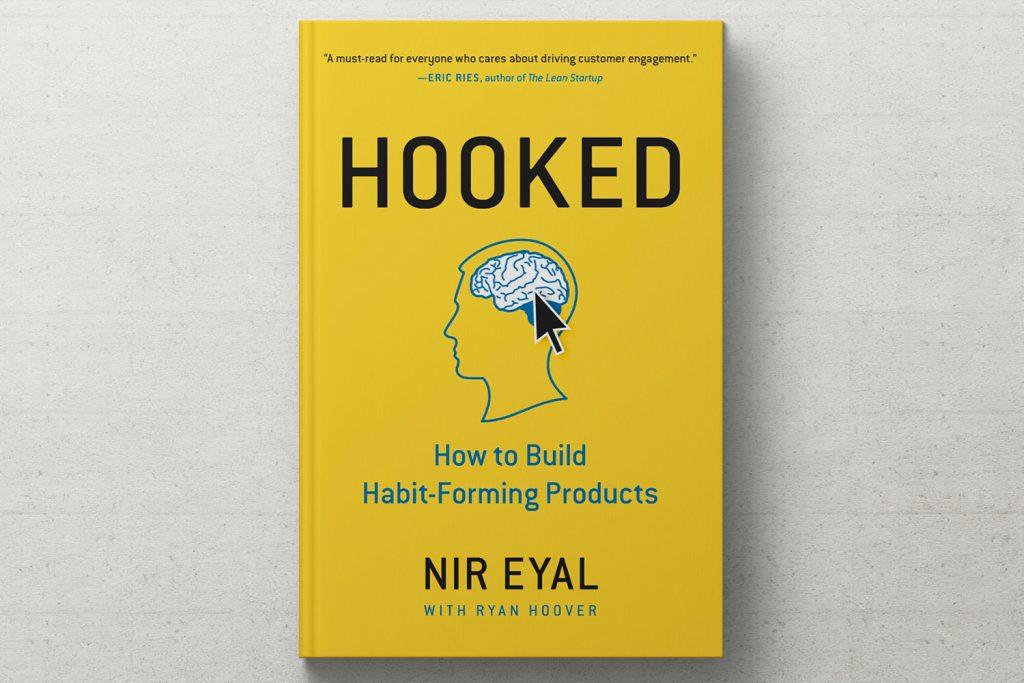
Nir Eyal is a behavioural design expert who knows a thing or two about mastering this superpower. His first book, Hooked, took the Promethean torch of how to create habit-building products and passed it from the tech gods to all of us, so that we might build positively addictive products and experiences that improve rather than detract from people’s lives.
And his second, Indistractable, teaches us how to resist the siren call of the many addictions we navigate on a daily basis and control how and where we spend our attention.
Contrary to popular belief, this doesn’t just mean mastering our technology, but also mastering our internal motivations, so that we can become the people we truly want to be.
So as experience designers, what can we learn from Eyal’s strategic model for becoming indistractable? How can we master our own attention, and also help those we work with and create experiences for to master theirs?
Whether you’re looking to build an indistractable workplace, resist the tyranny of your to-do list, or understand whether meditation is really worth the effort, here’s how to develop the superpower of indistractability for yourself.
Sink Or Hook?

In Eyal’s first book, Hooked, he explained how to steal the secrets of the Facebooks and Twitters of the world to build habit-forming products.
Creating consumer habits is critical for the survival of many products. SaaS products like Salesforce can’t work if people don’t use them with sufficient frequency. Education programmes require people to get to the end of them for them to have any value. And failure to use a healthcare device regularly can actually harm people.
“Many products and services require that we get people hooked, or we’re sunk.”
Nir Eyal
Eyal’s book democratises the psychology behind these products, so that we can use them not only to build things for frivolity, but also to build healthier habits and improve people’s lives. Addiction doesn’t have to be a curse; it can also be a gateway to becoming the people we want to be.
The Greatest Superpower Of The 21st Century
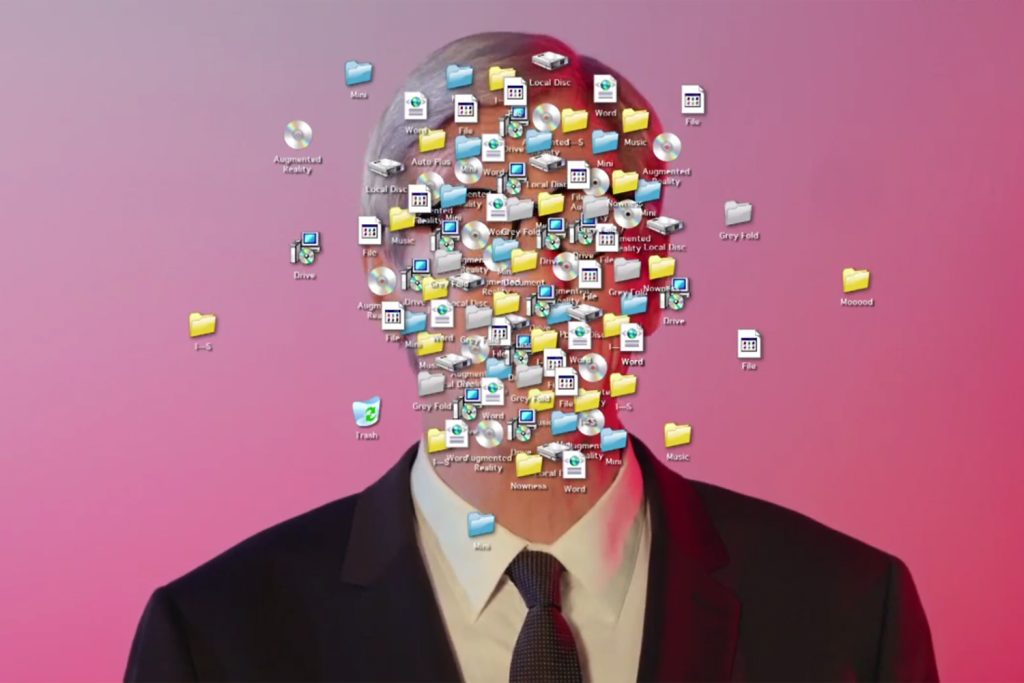
However, sometimes companies are a bit too good at creating these habit-forming products, as anyone who’s ever lost days to the doom scroll or got addicted to inbox zero can attest. We use them to the extent that we get distracted from what really matters.
Eyal recounted a time he asked his daughter what her superpower would be. However, distracted by whatever was on his phone, by the time his attention returned to her she’d gone – and the moment was lost forever.
“The superpower I think is the most important of the 21st century is the power to be indistractable. How we control our attention is how we control our life. If you don’t control it, someone will control it for you.”
Nir Eyal
Whether it’s our physical health, mental health, relationships or work, we have to become indistractable if we’re going to become our best selves: the heroes that we want to be.
Even Plato Got Distracted
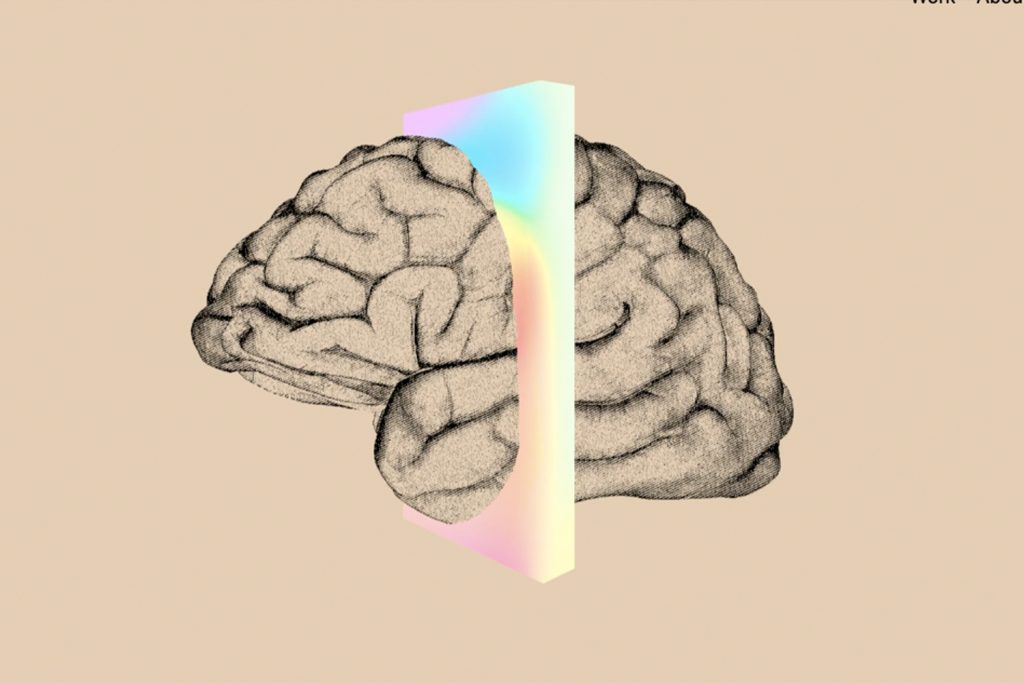
We tend to think that our tendency to be distracted is caused by modern technology – but in fact, distraction has been around since time immemorial.
Plato called it “akrasia”, or the tendency to do things against our better judgement, 2,500 years before the internet arrived. The Stoics also had a thing or two to say about mastering our instincts and controlling our actions. You don’t need a smartphone to be distracted – just a human brain.
The root cause of our distraction therefore goes much deeper than technology. Fortunately, it’s also much more actionable than we give it credit for.
The Opposite Of Distraction Is…
To understand how to tackle distraction, we need to properly understand what it is.
If asked to give the opposite of distraction, most people would probably say focus. But this isn’t quite right.
If you look at the etymology of the word, the opposite of distraction is actually traction. Both are rooted in action:
- Traction is an action that moves you closer to your goals and values.
- Distraction is an action that pulls you away.
Distraction therefore isn’t something that happens to us, but instead an action we take.
The Time You Plan To Waste Is Not Wasted Time

Any action has the potential to be either a traction or a distraction. The key word that decides which direction it swings is intent.
Whatever you want to do with your time is fine – as long as you choose to do it according to your values and your schedule, and certainly not those of a tech company. As the writer Dorothy Parker said, “the time you plan to waste is not wasted time.”
The brilliant news is that this means we can stop moralising and medicalising distraction. If you want to spend two hours watching TikTok dances or mainlining back-to-back Bridgerton, you don’t need to feel guilty as long as it’s what you intended to do.
The bad news is that we’re not always that good at realising when we’re being distracted and wasting time. Most distractions aren’t what we think they are – they can even trick us into thinking we’re being productive.
Take sitting down at your desk for the day. How many of us decide to run through our inbox and our to-do list as a first step? We might feel that we’re being productive – but as we neatly folder away our emails and tick off the easy and urgent tasks, we ignore the hard and important work we have to do in order to move our careers and our lives forward.
“If it is not what you said you were going to do in advance, it’s just as much of a distraction as playing a video game.”
Nir Eyal
Why Trigger Happy Makes You Unhappy

To become truly indistractable, we have to understand the triggers that pull us away from our intentions.
Most people think that external triggers – the pings and dings in our environment like our phone, the news, our kids, our boss – are to blame. But actually, studies have shown that this only accounts for 10% of our distraction.
The other 90%? Internal triggers: those uncomfortable emotional states that we seek to escape. If we don’t accomplish our goals, it’s probably not because there’s something in our external environment holding us back: it’s because we don’t feel like doing the behaviour.
We don’t lose weight, because we don’t feel like eating right. We don’t get fit, because we don’t feel like exercising. And we don’t meet our deadlines, because we don’t feel like doing the work right now.
Your Strategy For Becoming Indistractable
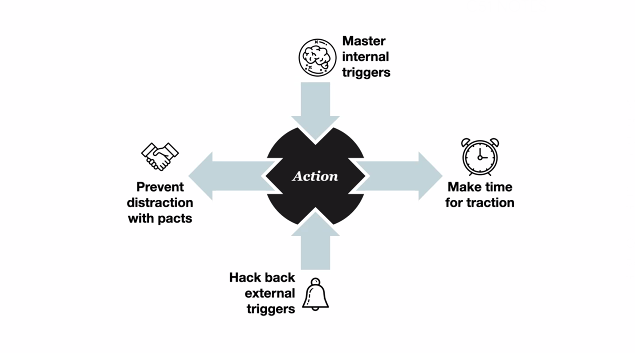
Individually understanding triggers is just one tactic in a wider strategy. And tactics alone don’t work, as you need to understand why you’re doing them and approach them strategically.
If you try to jump to hacking back external triggers as a quick fix – turning your phone to grayscale or getting rid of all your apps, for example – without dealing with internal triggers, you’re bound to fail, as you’ll find a way around them.
“When I was writing my book I stopped using all technology. Guess what? I’d say, ‘oh, there’s a book on my bookshelf that I’ve been meaning to finish up’, or ‘look, my desk needs some cleaning up’, or ‘look, the trash should probably be taken out’. I kept getting distracted because I didn’t understand the root cause of the problem.”
Nir Eyal
Eyal has therefore designed a model for becoming truly indistractable that combines tactics into a strategic whole:
- Master internal triggers. If we don’t master them, they will master us.
- Make time for traction. Time-boxing is the most studied time-management technique in history, and has been shown to be the most effective thing you can do. This is because you can’t call something a distraction unless you know what it’s distracted you from. It all comes back to intent: if you set what you intend to do with your time, you’re less likely to be unknowingly distracted.
- Hack back external triggers. This doesn’t just mean technology, although it’s part of it. It also means being aware of other distractions – like pointless meetings, or our kids getting in the way when we’re working from home – that can pull us away from our intentions, and figuring out the best tactics to prevent them doing do.
- Prevent distraction with pacts. When all else fails, if we set up pre-commitments we’re more likely to stick to what we said we were going to do.
The Indistractable Workplace
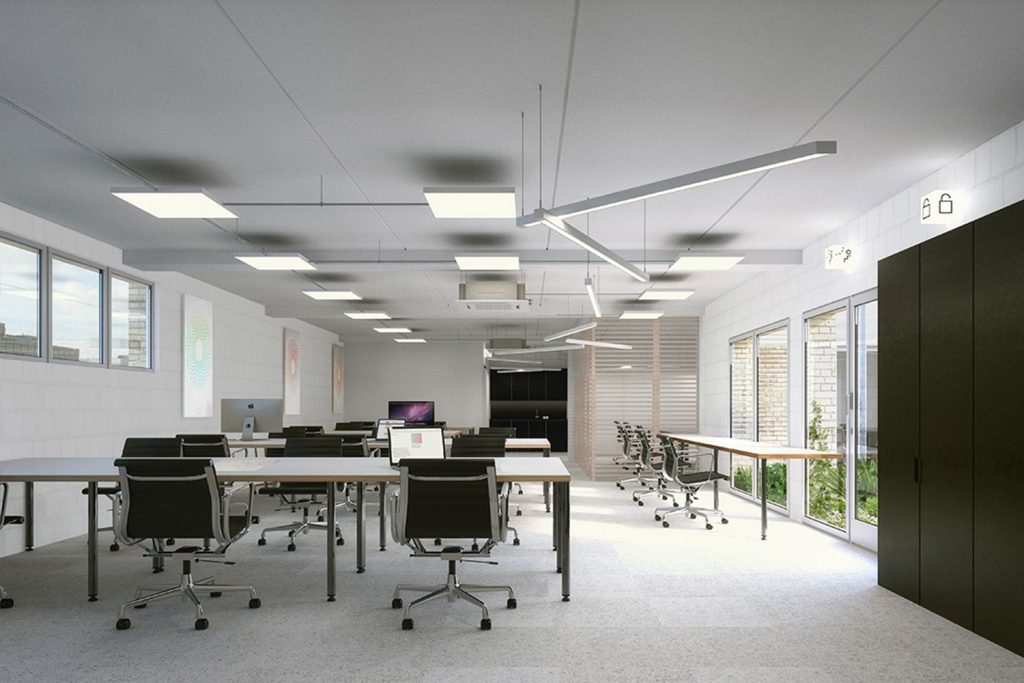
After this impressively whistlestop guide to being indistractable, we opened up the floor to our Campfire.
“Part of my work focuses on employee experience, and trying to put people into a flow where they feel like they’re getting to do the work they want, but in line with the work that needs to be done. How do you get that balance of happiness and productivity?”
Alain Thys
Studies have shown that when it comes to technology, email and group messaging are the biggest distractions in the workplace. However, technology isn’t the biggest distraction overall – that honour goes to other people. And Eyal found that when he visited group messaging company Slack, far from being the most distracted company on Earth, it’s incredibly indistractable.
This is because it embodies three of Eyal’s key characteristics for an indistractable workplace:
- Management shows people how to be indistractable. Eyal pointed out that when he’s previously given corporate workshops on the value of not being distracted, it wasn’t the tech millennial who couldn’t get off their phone – it was the big boss who was too important to put it down. One of the best things we can do is therefore lead by example. At Slack, there’s a neon-pink sign in the canteen that says “Work hard and go home”, and staff are reprimanded for using Slack at nights or weekends. As a company, it’s recognised that to do your best work, you need time to think.
- People have psychological safety, i.e. the ability to talk about problems without fear of retribution. Distraction is a symptom of a cultural dysfunction, where problems with the working culture aren’t being surfaced or dealt with. Boston Consulting Group used to have terrible turnover, but after introducing the idea of “predictable time off”, it’s now one of the best companies to work for in the USA.
- People have a forum to talk about problems. At Slack, they give people a forum called “BeefTweets” on Slack where employees can say what would make their work lives better. Managers don’t necessarily have to action every comment, but they do have to acknowledge it, usually through an emoji reaction that shows the employee has been heard and understood.
Reactive Versus Reflective Working

“One of the big problems we’re facing is that working hours are going up everywhere. When we’re giving workshops, people might be engaged – but then they’re returning to a 70-hour week and the learning is lost. How do you embed this change in the long term?”
Greg Palmer
One of the problems with presenteeism and spending lots of time behind our desk is that as Eyal pointed out earlier, even when we think we’re being productive, we’re actually still being distracted. This is because there’s a difference between:
- Reactive work: reacting to emails, meetings or other notifications.
- Reflective work: strategising, planning and being creative.
It’s easy to waste huge amounts of time on reactive work – and in fact low performers are more likely to spend most of their time doing just this. Reactive work can also be very comforting, as rather than having to think about what you really want to do with your career or your life, you can just do what you’re told. But it’s in that reflective work that high performance – and high happiness – lies.
Researchers at the University of Oxford have also found that there’s a causal relationship between workplaces where high expectations are coupled with low control, and anxiety and depression. Harvard’s Leslie Perlow has found that when you add technology to the mix, you get a “cycle of responsiveness” that looks like this:
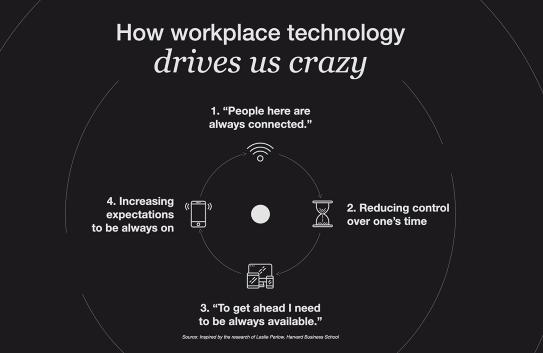
As your sense of agency decreases, so does the expectation to be always on. Technology therefore isn’t the source of the problem, but the accelerant of a sick workplace environment that leads to distraction.
Stop Optimising For Flow
“Flow is like Hollywood – it’s nice work if you can get it!”
Nir Eyal
On the surface, it seems like being indistractable would be compatible with a state of flow, when we’re totally immersed in the here and now. (For more on how to build flow into your experiences, check out Campfire 30: How To Design For Flow.) But Eyal thinks that aiming for happiness and flow is a problem, as if we’re setting an expectation that we’ll enjoy every task, we’re also setting ourselves up for failure.
“If you read [Mihaly Csikszentmihalyi’s] Flow, all the examples are of creative people doing things they love. But how do I get into flow doing my taxes? Nobody knows, because you can’t.
When people say they want to develop a habit, they want to ‘have it’ – because they hate the activity they’re describing. They want to develop an exercise habit so they will have exercised, because they hate it. They want to get into a writing habit so they have written, because they hate writing.
The opposite of flow is deliberate practice. We have to be fully present, focusing on our mistakes and not necessarily enjoying the process. When we set an expectation of flow, we procrastinate, we look for the muse, and we’re not being professionals.”
Nir Eyal
Is flow truly incompatible with being indistractable? As Stephen King says in his book On Writing, lazy people think the flow will come to them – but it’s up to the individual to keep showing up day after day so the muse knows where you are when it arrives. You need a future goal, but when you look at the conditions for flow, they work really well with these ideas of timeboxing and traction. However, Eyal still isn’t convinced.
“Flow is meant to be a suspension of time that is supremely enjoyable – but this isn’t a requirement for work. To be indistractable, you need to know what to do when the work sucks and you don’t want to do it. If we make flow a requirement, people think they’re broken when they’re not – it’s the technique they’re using.”
Nir Eyal
The Tyranny Of The To-Do List

“I rally against running your life on a to-do list.”
Nir Eyal
To-do lists might feel like the most productive way to organise our lives, but according to Eyal they’re a massive mistake. This is because they have no constraints – there’ll always be things that you haven’t done.
When you see this day after day, it can be really psychologically damaging and instil a belief that you’re bad at time management or lazy. It also erodes the true enjoyment of your leisure time, as you’ll always have the things you haven’t done at the back of your mind and will be unable to be fully present in the moment.
Peter Monbailleu wondered what the better alternative to the to-do list could be. Eyal’s answer? Timeboxing.
“If the first thing you look for is your to-do list rather than your calendar, that’s a mistake. A calendar forces you to make trade-offs, as we all only have 24 hours in the day.
Once a week, plan ahead. First put in time for yourself – for sleep, reading, meditation, etc. Then put in time for your relationships – your friends, kids, spouse. Finally, put in time for work – and make sure it’s not only reactive work, but also – and especially – reflective work.
By giving yourself these constraints, you can achieve real freedom.”
Nir Eyal
Tools In the Indistractable Toolbox

“There is no magic bullet. You’ve got lots of tools in a toolbox. Sometimes you use the hammer, sometimes you use the wrench.”
Nir Eyal
Pigalle Tavakkoli has worked with sports scientists on a project that showed that world-class athletes use meditation as part of their training, in order to become more aware of how they direct their attention. In our attention economy, where our biggest value is where we direct this, she wondered if meditation had a big role to play in becoming indistractable.
But as the strategic model for becoming indistractable shows, there isn’t an easy hack to achieve this state of being. Instead, you have to attack it with as many tools as you can find that work for you.
“If meditation benefits your life, keep doing it. Unfortunately, it’s not a cure-all. What happens with meditation is very similar to what happens with brain-training games. They don’t make you smarter – they just make you better at the game. And research shows that meditation makes you better at meditating. Some people think we can meditate our problems away, but sometimes the solution is to actually go and fix the problem.”
Nir Eyal
To discover which tool to use, we also need to learn to ask the right questions. University professor Mike Lai wanted to know how to make students understand the value of knowledge that they might not need now, but could be valuable years down the road.
“I think we should flip the question and ask ourselves why are we asking for this? Research shows that accessing information later on is hard, especially in an age of embedded cognition through Google.
So how do we change the pedagogy of what we teach, knowing that people will learn better if they can actually use the information when it’s needed?”
Nir Eyal
Can Purpose Make Us Indistractable?

“Beyond healthy habits, it’s about building products that increase meaning and fulfil the greater purpose of our lives.”
Pigalle Tavakkoli
Our addictions are to do with getting a quick release of serotonin and dopamine, which can create a cycle of dependency. But Tavakkoli argues that if we can design experiences that help us get into a state of flow and move us towards fulfilling our greater purpose, the impact of those quick fixes is reduced.
“The feeling I get from a life-changing experience can last me the rest of my life, as the memory of it will trigger those same feelings.
In experience design, the external things are just tools to trigger internal motivations. External stimulation is about entertainment; internal stimulation is about transformation.”
Pigalle Tavakkoli
This reminds us of the distinction between the short-term hit of a hedonic experience versus the long-term pleasure that diffuses from a eudaimonic experience, as explored in Campfire 39: How To Design For Creativity And Curiosity.
The WXO Take-Out
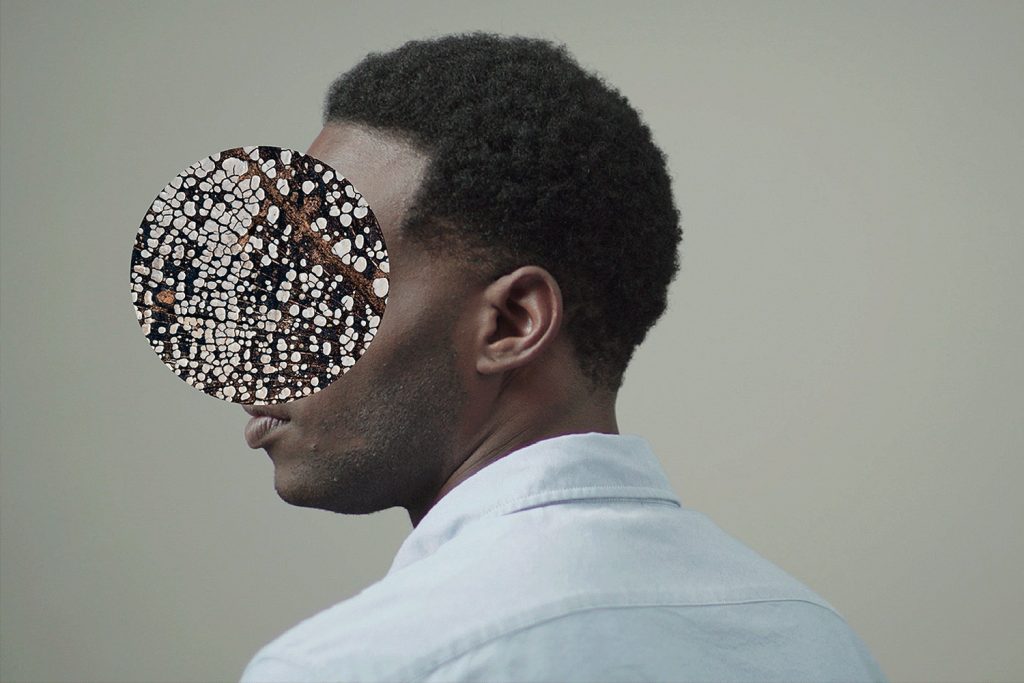
Although designed for individuals, Eyal’s strategic model for becoming indistractable is useful for experience designers as it not only helps us understand how to master our own internal and external triggers, but also the battle for their attention that our audiences are facing when they enter our experiences.
As we explored in Campfires 48 & 49: Who Wants To Be An Experience Alchemist?, behavioural psychology has taught us that the smallest tweaks can have a huge impact on people’s behaviour and perceptions.
With this in mind:
- How do we inspire people to care enough to invest in our experiences?
- How do we create shared goals?
- And how do we design structures and triggers that create a smoother path to transformation?
Want to be part of the most inspiring experience conversations in the world? Apply to become a member of the World Experience Organization here – to come to Campfires, become a better experience designer, and be listed in the WXO Black Book.





